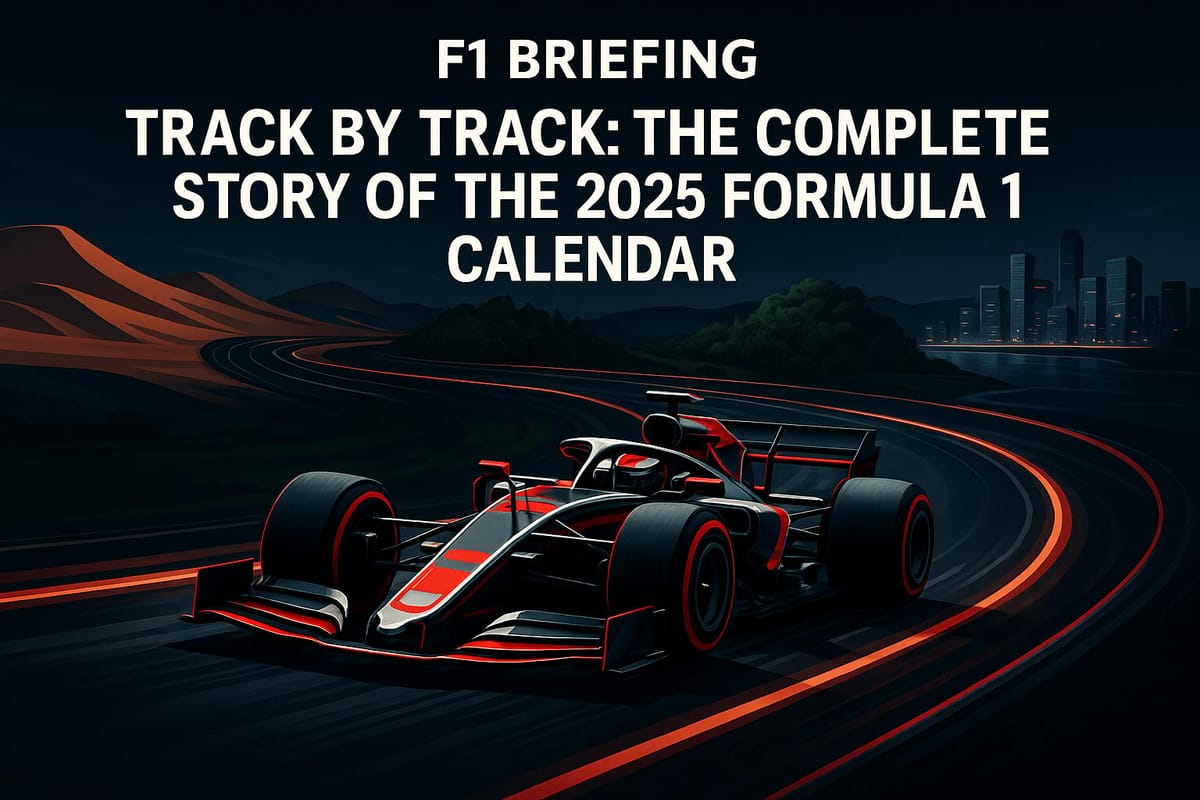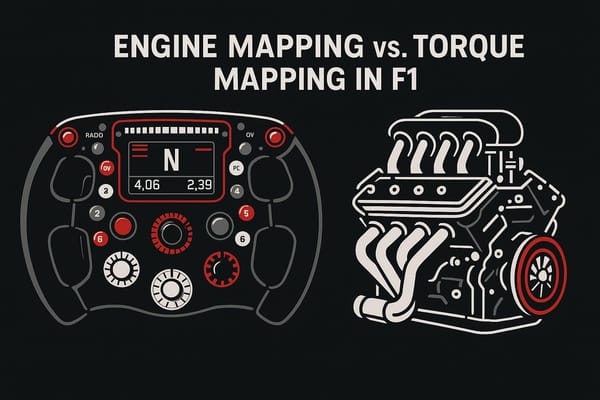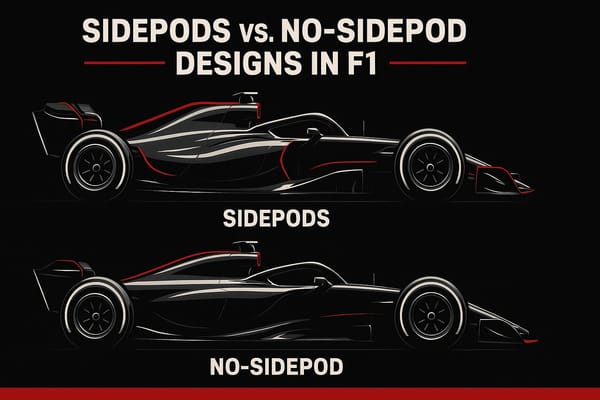Track by Track: The Complete Story of the 2025 Formula 1 Calendar
Explore the 2025 Formula 1 calendar, featuring new circuits, sustainability efforts, and the challenges of diverse racing tracks.

Key Highlights:
- Season Opener: Australia returns as the first race (March 14–16), replacing Bahrain.
- Sprint Races: Six locations, including Spa-Francorchamps and Miami, bring excitement.
- Geographical Grouping: Improved race flow reduces travel and aligns with sustainability goals.
- Season Finale: Abu Dhabi (Dec 5–7) hosts the championship's conclusion.
What’s New:
- Calendar Adjustments: No long gaps, smoother mid-season flow, and Ramadan considerations.
- Technical Challenges: Tracks like Monaco, Monza, and Suzuka demand unique car setups.
- Sustainability Focus: Regionalized scheduling to cut emissions and travel strain.
From high-speed circuits like Monza to technical tracks like Suzuka, the 2025 calendar tests teams with a variety of challenges. As the season celebrates its historic anniversary, expect thrilling races, bold strategies, and a fitting finale in Abu Dhabi.
F1 2025: Complete Race Calendar Breakdown - Championship Battles & Circuit Analysis
Track Types and Racing Demands
The 2025 Formula 1 calendar features a variety of circuits, each with unique challenges that influence car setups, driving styles, and race strategies. Let's dive into the specific demands of these tracks based on their aerodynamic and performance characteristics.
Tracks Requiring Maximum Downforce
The Circuit de Monaco, home to the Monaco Grand Prix, spans 3.337 km (2.074 miles) and is known for its narrow layout, tight corners, and limited overtaking opportunities. Similarly, the Marina Bay Circuit in Singapore calls for high downforce to navigate its demanding twists and turns.
Key considerations for these tracks include:
- Qualifying importance: Limited overtaking opportunities make grid position critical.
- Mechanical grip: Maximizing grip in slow-speed corners is essential for competitive lap times.
- Safety car strategies: Teams must account for the high likelihood of safety car deployments.
"Towards the end of the race the tyres I had were nowhere close to fresh, but I saw the only way to win the race was to stay out."
High-Speed Tracks
High-speed circuits in 2025 push cars to their limits in terms of top-end performance. Monza, famously called the "Temple of Speed", is the ultimate test of low-drag aerodynamics and straight-line speed. Meanwhile, the Las Vegas Strip Circuit combines high-speed sections with the added complexity of cold night racing and variable road surfaces.
Performance at these tracks depends on:
| Track Feature | Impact on Performance | Technical Requirement |
|---|---|---|
| Long Straights | Higher top speeds | Low-drag aero package |
| Cold Conditions | Reduced tire grip | Adjusted tire warm-up strategies |
"It's crazy fast, like a street circuit on steroids", says Max Verstappen.
The 2023 Las Vegas Grand Prix highlighted these challenges, with teams grappling with low grip caused by cold temperatures and the unique surface of city roads.
Mixed-Requirement Tracks
Some circuits demand a more balanced approach, testing both car performance and driver skill. Suzuka and Silverstone are prime examples. Suzuka's figure-eight layout blends fast, flowing sections with tight, technical corners, forcing teams to find a compromise in their setups. At Silverstone, drivers face a mix of high-speed straights and slower, more technical turns, requiring adaptability.
At these tracks:
- Teams must strike a balance between aerodynamic efficiency and sufficient downforce.
- Drivers need to adjust their techniques to handle quick transitions between fast and technical sections.
"Every time you go there it's interesting, because you are a few centimetres every lap from the barrier, so in terms of focus, it's really intense", shares Pierre Gasly.
Complete Circuit Guide: 2025 Season
The 2025 racing calendar features a variety of circuits, each bringing unique challenges that influence race strategies and championship battles.
Melbourne: Track Updates and Racing Lines
Albert Park Circuit now boasts four DRS zones, designed to encourage closer racing and more overtaking opportunities. Michael Schumacher still holds the record here with four wins, a testament to the track's technical nature and the precision it demands.
"The atmosphere in Melbourne is always unreal, and the track is fun and fast." – Daniel Ricciardo
Jeddah: Night Racing Specifics
From the streets of Melbourne, the action shifts to Jeddah, a circuit that pushes drivers to their limits under floodlights. With an average speed of 155 mph, this Middle Eastern track demands sharp car setups and adaptability to night racing conditions. Max Verstappen has claimed victory here twice, showcasing the level of skill required to excel.
Las Vegas: Street Circuit Challenges
Las Vegas brings a completely different vibe to the season. The Strip Circuit combines high-speed racing with the city's signature flair for entertainment. Drivers face the challenge of managing a street circuit while soaking in the glitz and glamor of Vegas.
"It's Vegas, baby. This one's all about the spectacle." – Logan Sargeant
Suzuka: Technical Section Analysis
Suzuka stands out for its high-speed sections and challenging corners. Michael Schumacher's six wins here highlight the importance of experience and precision on this iconic track.
"It's great because it's very demanding, and perfect for Formula 1 cars. You can use all the potential of these cars and their aerodynamic performance as they match perfectly with the corners at Suzuka." – Fernando Alonso
Adding to the complexity, Suzuka’s tendency for wet weather introduces an extra layer of strategy, making tire decisions pivotal.
Interlagos: Weather Impact and Passing Zones
Autódromo José Carlos Pace, better known as Interlagos, is a fan favorite that mixes technical corners with plenty of overtaking opportunities. The unpredictable weather here often shakes up race strategies, especially when it comes to tire choices.
"The energy at Interlagos is electric. You feel the history." – Felipe Massa
Technical Requirements by Track
Each track's unique layout and conditions demand specific technical setups, pushing teams to fine-tune their cars for peak performance.
Track-Specific Aero Settings
Aerodynamic adjustments play a pivotal role in adapting to the unique challenges of each circuit. For example, Monza's long straights and speeds exceeding 160 mph call for low downforce configurations to prioritize straight-line speed. On the other hand, the Hungaroring's tight, twisty layout demands maximum downforce to navigate its sharp corners effectively.
"At every race weekend, Pirelli will nominate three of its compounds to go to each race, based on the circuit and its predicted levels of degradation, often opting for their softest compounds at street circuits such as Monaco and Singapore, and their hardest at high-wear circuits like Suzuka and Silverstone." - Pirelli
Similarly, the Jeddah Corniche Circuit, with its average speeds of around 155 mph, presents a unique challenge. Teams must strike a balance between maintaining downforce for its technical sections and reducing drag for its high-speed straights.
Tire Management by Circuit
Tire strategy is another critical factor that varies depending on track characteristics and environmental conditions. Pirelli's transition to 18-inch tires for the 2025 season, along with six dry compound options, provides teams with fresh opportunities to tailor their strategies.
| Circuit Type | Primary Tire Strategy | Key Considerations |
|---|---|---|
| Street Circuits (Vegas, Jeddah) | Softer compounds | Higher tire wear and thermal management |
| High-Speed (Monza, Spa) | Medium to hard compounds | Balancing grip and durability |
| Technical (Suzuka, Barcelona) | Mixed compound strategy | Surface temperature effects |
In addition to aerodynamic and tire considerations, managing fuel and brake systems is equally important for consistent performance across challenging circuits.
Fuel and Brake Setup Requirements
Racing at high-altitude circuits like the Autodromo Hermanos Rodriguez in Mexico City, situated 2,200 meters above sea level, introduces unique hurdles. The thinner air - 25% less dense than at sea level - impacts engine cooling and brake efficiency.
To address these challenges, teams implement key modifications:
- Expand cooling outlets to enhance airflow.
- Optimize brake ducts to prevent overheating during the race.
"Cooling the car appropriately is probably the biggest challenge in Mexico." - Mercedes-AMG PETRONAS F1 Team
At Interlagos, which sits 800 meters above sea level, teams encounter moderate altitude effects. The combination of elevation and the circuit's technical corners requires meticulous brake and fuel management to maintain optimal performance throughout the weekend.
Championship Impact of Track Sequence
The arrangement of circuits in the 2025 calendar plays a pivotal role in shaping the championship's trajectory.
Season-Deciding Circuits
Interlagos, with its 4.3-km layout, is a true test of both car performance and driver skill. Known for its history of dramatic title showdowns, this iconic circuit drew a staggering 292,000 fans over three days in 2024. While the late-season races often carry the most pressure, the groundwork for these thrilling finales is laid during the earlier rounds, where teams often employ bold strategies to gain an edge.
Season-Opening Impact
Even though championships are typically clinched toward the end, the early races are crucial for setting the tone. These initial rounds allow teams to gather critical performance data across a variety of track types in Asia and the Middle East. This information becomes the foundation for implementing significant car upgrades, often showcased at the Miami Grand Prix.
| Circuit Phase | Key Characteristics | Championship Impact |
|---|---|---|
| Opening Races | High-speed tracks (Miami) | Builds early momentum |
| Mid-Season | Technical circuits (Hungaroring) | Positions teams strategically |
| Final Stretch | Mixed challenges (Interlagos) | Decides the championship |
Mid-Season Critical Races
The mid-season calendar features some of the most grueling circuits in Formula 1. Spa-Francorchamps, with its high-speed sections and unpredictable weather, pushes teams to their limits. Silverstone’s ultra-fast layout demands exceptional technical precision and continuous car development. Meanwhile, the tight, twisting Hungaroring and Monaco’s famously narrow streets require adaptability and pinpoint accuracy. This stretch of the season highlights how the calendar’s design compels teams to evolve their strategies and refine their cars as the year progresses.
Conclusion: 2025 F1 Calendar Impact
The 2025 Formula 1 calendar brings together 24 circuits across 21 countries and five continents, showcasing a truly global and dynamic racing season. By carefully organizing the schedule to improve geographical flow, Formula 1 not only manages to cut down on travel costs but also takes steps to lessen its environmental footprint. This layout, paired with the variety of circuits, keeps teams on their toes, demanding constant adjustments and evolving race strategies throughout the season.
From the high-speed demands of Monza to the thin air at Mexico City's Autódromo Hermanos Rodríguez, perched over 2 km above sea level, teams face a wide range of technical challenges. These hurdles require precise tuning and adaptability to ensure optimal performance. Additionally, the structure of the calendar itself plays a significant role in shaping the championship, with more sprint events adding new layers of unpredictability and momentum shifts.
"2025 will be a special year as we celebrate the 75th Anniversary of the FIA Formula One World Championship, and it's that legacy and experience that allows us to deliver such a strong calendar." – Stefano Domenicali, Formula 1 CEO and President
The importance of timely technical upgrades is evident, as seen with McLaren's Miami package in 2024. Meanwhile, unpredictable weather at circuits like Interlagos and grueling conditions at Marina Bay only heighten the strategic complexity of the season.
The year will culminate at Abu Dhabi, a track synonymous with dramatic finales, including the unforgettable 2010 four-way title battle. As Formula 1 celebrates its 75th anniversary, the stage is set for another electrifying conclusion to a season filled with challenges, excitement, and history in the making.
FAQs
How does grouping races by region in the 2025 Formula 1 calendar help improve sustainability and reduce costs?
The 2025 Formula 1 calendar has been restructured to create a more logical regional flow, aiming to reduce both travel-related carbon emissions and logistical costs. For instance, races in the Asia-Pacific region, such as the Japanese Grand Prix, are now scheduled closer together. Similarly, events in the Middle East, including the Qatar Grand Prix, have been timed to align with the Abu Dhabi race.
Looking ahead to 2026, the Canadian Grand Prix will be moved to an earlier slot in the year, while European races, like the Monaco Grand Prix, will be grouped into a single stretch in June. These changes are designed to cut down on unnecessary transatlantic travel, helping to lessen the sport’s environmental impact while streamlining operational expenses.
What unique technical challenges do teams face on high-speed circuits like Monza compared to more complex tracks like Suzuka?
On high-speed tracks like Monza, teams focus on cutting drag to boost straight-line speed. This usually means opting for low-downforce rear wings tailored for such circuits, though this can impact the car's aerodynamic balance. To counter this, adjustments to the front wing and suspension setups are essential for maintaining stability while keeping resistance to a minimum.
On the flip side, technical circuits like Suzuka call for a completely different approach. With its fast corners, elevation changes, and tricky sections like the Esses, downforce and precise handling take center stage. Here, teams must strike a fine balance between aerodynamics, tire management, and car setup to tackle the track's diverse challenges effectively.
How will the 2025 Sprint races affect team strategies and the championship battle?
The 2025 Sprint races, taking place across six Grand Prix weekends, bring an added layer of intensity and tactical decision-making to the season. These Saturday events cover a shorter 100 km distance and offer points to the top eight finishers, directly impacting the Drivers' and Constructors' Championship standings. However, they don't decide the starting grid for Sunday's main Grand Prix.
Sprint weekends come with less practice time, forcing teams to quickly dial in their car setups. Once parc fermé rules kick in at the start of Sprint Qualifying, teams face restrictions on adjustments until after the Sprint. While this limits pre-Sprint tweaks, teams can make further changes for the Grand Prix. Any penalties during the Sprint carry over to Sunday, making each move on track a calculated risk. This format pushes teams to weigh short-term gains against long-term goals, shaping strategies for both individual races and the championship battle.




